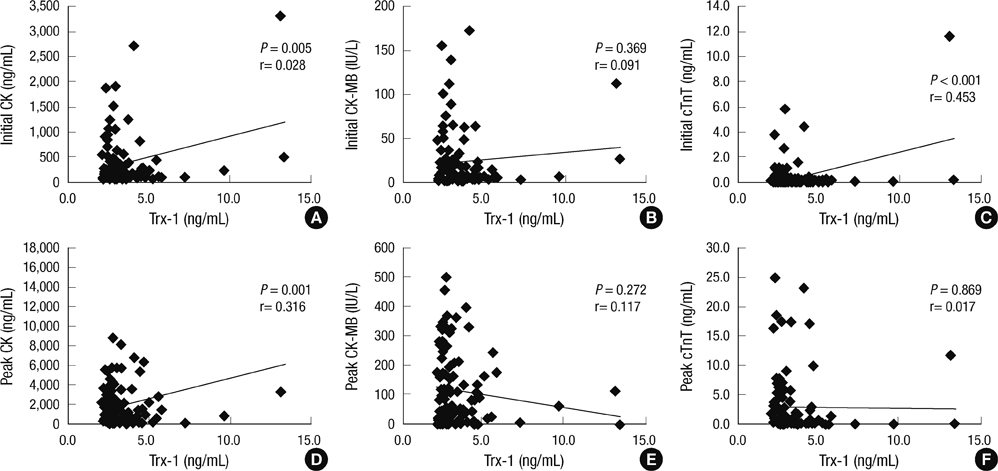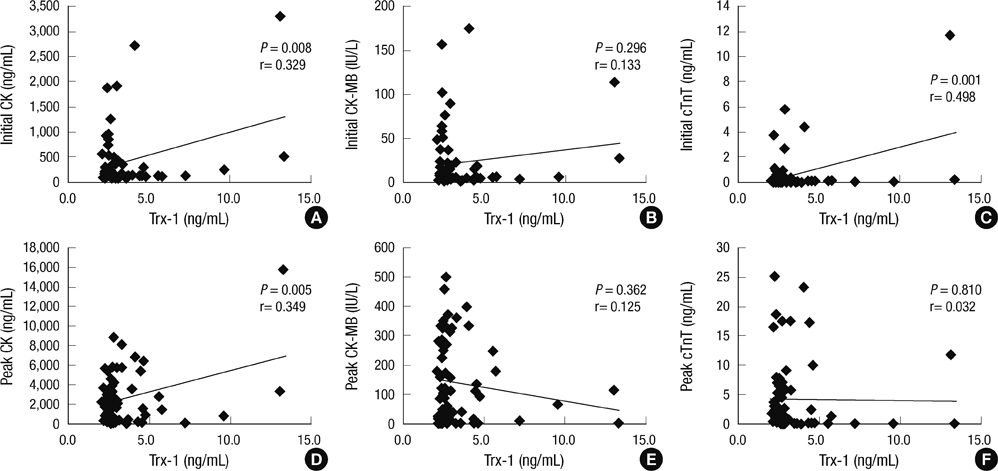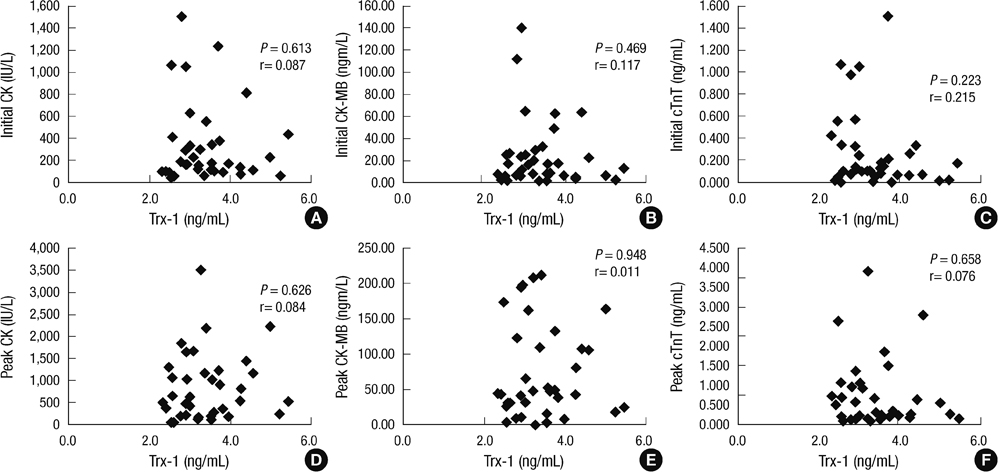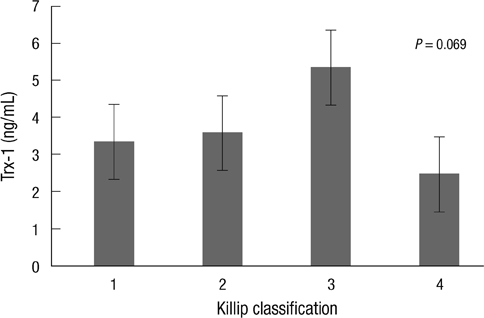J Korean Med Sci.
2012 Oct;27(10):1162-1169. 10.3346/jkms.2012.27.10.1162.
Serum Thioredoxin 1 Level Has Close Relation with Myocardial Damage Amount in Acute Myocardial Infarction Patients
- Affiliations
-
- 1Regional Cardiovascular Disease Center, Division of Cardiology, Department of Internal Medicine, Chungbuk National University Hospital, Cheongju, Korea. drcorazon@hanmail.net
- 2Regional Cardiovascular Disease Center, Division of Cardiology, Department of Internal Medicine, Jeju National University Hospital, Jeju, Korea.
- KMID: 1778821
- DOI: http://doi.org/10.3346/jkms.2012.27.10.1162
Abstract
- Thioredoxin-1 (Trx-1) is one of important anti-oxidative molecules to overcome the oxidative stress. The aim of the present study is to investigate the clinical relationship between serum concentration of Trx-1 on the pre-percutaneous coronary intervention (prePCI) and myocardial damage amount in the patients with acute myocardial infarction with the culprit lesion in only the left anterior descending artery on coronary angiography (n = 100). Initial value of creatine kinase (CK) was 368.3 +/- 531.4 U/L, and MB isoenzyme of CK (CK-MB) level was 22.92 +/- 33.8 ng/mL, and cardiac specific troponin T (cTnT) level was 0.61 +/- 1.6 ng/mL. Positive correlations were observed between prePCI Trx-1 level and initial CK (P = 0.005, r = 0.281), and cTnT (P < 0.001, r = 0.453), peak CK (P = 0.001, r = 0.316) in all patients, but the statistical relation was observed only in ST segment elevation myocardial infarction (STEMI) patients (P = 0.008, r = 0.329 for initial CK, P = 0.001, r = 0.498 for initial cTnT, P = 0.005, r = 0.349 for peak CK), not in Non-STEMI patients. Conclusively, we consider prePCI serum Trx-1 as a predictor for myocardial damage amount in patients with STEMI.
MeSH Terms
-
Acute Disease
Adult
Aged
Biological Markers/blood
Coronary Angiography
Creatine Kinase/blood
Creatine Kinase, MB Form/blood
Echocardiography
Female
Humans
Male
Middle Aged
Myocardial Infarction/*blood/pathology
Myocardium/*pathology
Percutaneous Coronary Intervention
Thioredoxins/*blood
Troponin T/blood
Biological Markers
Troponin T
Thioredoxins
Creatine Kinase
Creatine Kinase, MB Form
Figure
Reference
-
1. Nordberg J, Arner ES. Reactive oxygen species, antioxidants, and the mammalian thioredoxin system. Free Radic Biol Med. 2001. 31:1287–1312.2. Takimoto E, Kass DA. Role of oxidative stress in cardiac hypertrophy and remodeling. Hypertension. 2007. 49:241–248.3. Nakamura H, Nakamura K, Yodoi J. Redox regulation of cellular activation. Annu Rev Immunol. 1997. 15:351–369.4. Ago T, Sadoshima J. Thioredoxin and ventricular remodeling. J Mol Cell Cardiol. 2006. 41:762–773.5. Liu W, Nakamura H, Shioji K, Tanito M, Oka S, Ahsan MK, Son A, Ishii Y, Kishimoto C, Yodoi J. Thioredoxin-1 ameliorates myosin-induced autoimmune myocarditis by suppressing chemokine expressions and leukocyte chemotaxis in mice. Circulation. 2004. 110:1276–1283.6. Tao L, Jiao X, Gao E, Lau WB, Yuan Y, Lopez B, Christopher T, RamachandraRao SP, Williams W, Southan G, et al. Nitrative inactivation of thioredoxin-1 and its role in postischemic myocardial apoptosis. Circulation. 2006. 114:1395–1402.7. Shioji K, Kishimoto C, Nakamura H, Masutani H, Yuan Z, Oka S, Yodoi J. Overexpression of thioredoxin-1 in transgenic mice attenuates adriamycin-induced cardiotoxicity. Circulation. 2002. 106:1403–1409.8. Park KJ, Kim YJ, Choi EJ, Park NK, Kim GH, Kim SM, Lee SY, Bae JW, Hwang KK, Kim DW, et al. Expression pattern of the thioredoxin system in human endothelial progenitor cells and endothelial cells under hypoxic injury. Korean Circ J. 2010. 40:651–658.9. Miwa K, Kishimoto C, Nakamura H, Makita T, Ishii K, Okuda N, Taniguchi A, Shioji K, Yodoi J, Sasayama S. Increased oxidative stress with elevated serum thioredoxin level in patients with coronary spastic angina. Clin Cardiol. 2003. 26:177–181.10. Kim KS, Han HS, Lee YS, Bae JW, Hwang KK, Kim DW, Joo SJ, Cho MC. Plasma thioredoxin level and its correlation to myocardial damage in patients with acute myocardial infarction who underwent successful primary angioplasty. Korean Circ J. 2006. 36:39–45.11. Soejima H, Suefuji H, Miyamoto S, Kajiwaram I, Kojima S, Hokamaki J, Sakamoto T, Yoshimura M, Nakamura H, Yodoi J, et al. Increased plasma thioredoxin in patients with acute myocardial infarction. Clin Cardiol. 2003. 26:583–587.12. Hokamaki J, Kawano H, Soejima H, Miyamoto S, Kajiwara I, Kojima S, Sakamoto T, Sugiyama S, Yoshimura M, Nakamura H, et al. Plasma thioredoxin levels in patients with unstable angina. Int J Cardiol. 2005. 99:225–231.13. Sheehan FH, Braunwald E, Canner P, Dodge HT, Gore J, van Natta P, Passamani ER, Williams DO, Zaret B. The effect of intravenous thrombolytic therapy on left ventricular function: a report on tissue-type plasminogen activator and streptokinase from the thrombolysis in myocardial infarction (TIMI Phase I) trial. Circulation. 1987. 75:817–829.14. Killip T 3rd, Kimball JT. Treatment of myocardial infarction in a coronary care unit. A two year experience with 250 patients. Am J Cardiol. 1967. 20:457–464.15. Gardin JM, Adams DB, Douglas PS, Feigenbaum H, Forst DH, Fraser AG, Grayburn PA, Katz AS, Keller AM, Kerber RE, et al. Recommendations for a standardized report for adult transthoracic echocardiography: a report from the American Society of Echocardiography's Nomenclature and Standards Committee and Task Force for a Standardized Echocardiography Report. J Am Soc Echocardiogr. 2002. 15:275–290.16. Mair J, Dienstl F, Puschendorf B. Cardiac troponin T in the diagnosis of myocardial injury. Crit Rev Clin Lab Sci. 1992. 29:31–57.17. Burke-Gaffney A, Callister ME, Nakamura H. Thioredoxin: friend or foe in human disease? Trends Pharmacol Sci. 2005. 26:398–404.18. Kishimoto C, Shioji K, Nakamura H, Nakayama Y, Yodoi J, Sasayama S. Serum thioredoxin (TRX) levels in patients with heart failure. Jpn Circ J. 2001. 65:491–494.19. Jekell A, Hossain A, Alehagen U, Dahlstrom U, Rosen A. Elevated circulating levels of thioredoxin and stress in chronic heart failure. Eur J Heart Fail. 2004. 6:883–890.20. Miyamoto M, Kishimoto C, Shioji K, Lee JD, Shimizu H, Ueda T, Yodoi J. Cutaneous arteriolar thioredoxin expression in patients with heart failure. Circ J. 2003. 67:116–118.21. Wahlgren CM, Pekkari K. Elevated thioredoxin after angioplasty in peripheral arterial disease. Eur J Vasc Endovasc Surg. 2005. 29:281–286.22. Yang Y, Ago T, Zhai P, Abdellatif M, Sadoshima J. Thioredoxin 1 negatively regulates angiotension II-induced cardiac hypertrophy through upregulation of miR-98/let-7. Circ Res. 2011. 108:305–313.23. Ebrahimian T, Sairam MR, Schiffrin EL, Touyz RM. Cardiac hypertrophy is associated with altered thioredoxin and ASK-1 signaling in a mouse model of menopause. Am J Physiol Heart Circ Physiol. 2008. 295:H1481–H1488.24. Park AM, Suzuki YJ. Effects of intermittent hypoxia on oxidative stress-induced myocardial damage in mice. J Appl Physiol. 2007. 102:1806–1814.25. Tao L, Gao E, Hu A, Coletti C, Wang Y, Christopher TA, Lopez BL, Koch W, Ma XL. Thioredoxin reduces post-ischemic myocardial apoptosis by reducing oxidative/nitrative stress. Br J Pharmacol. 2006. 149:311–318.26. Wu XW, Teng ZY, Jiang LH, Fan Y, Zhang YH, Li XR, Zhang YN. Human thioredoxin exerts cardioprotective effect and attenuates reperfusion injury in rats partially via inhibiting apoptosis. Chin Med J. 2008. 121:819–826.27. Bae MH, Lee JH, Lee SH, Park SH, Yang DH, Park HS, Cho Y, Jun JE, Chae SC. Serum uric acid as an independent and incremental prognostic marker in addition to N-terminal pro-B-type natriuretic peptide in patients with acute myocardial infarction. Circ J. 2011. 75:1440–1447.28. Basar N, Sen N, Ozcan F, Erden G, Kanat S, Sokmen E, Isleyen A, Yuzgecer H, Ozlu MF, Yildirimkaya M, et al. Elevated serum uric acid predicts angiographic impaired reperfusion and 1-year mortality in ST-segment elevation myocardial infarction patients undergoing percutaneous coronary intervention. J Investig Med. 2011. 59:931–937.29. Khaket TP, Ahmad R. Biochemical studies on hemoglobin modified with reactive oxygen species (ROS). Appl Biochem Biotechnol. 2011. 164:1422–1430.30. Lettino M, Toschi V. Impact of anemia and its treatment in patients with acute coronary syndromes. G Ital Cardiol (Rome). 2011. 12:327–332.
- Full Text Links
- Actions
-
Cited
- CITED
-
- Close
- Share
- Similar articles
-
- Plasma Thioredoxin Level and Its Correlation to Myocardial Damage in Patients with Acute Myocardial Infarction who Underwent Successful Primary Angioplasty
- Serum Myoglobin in the Early Phase of Acute Myocardial Infarction
- Invasive Treatment of Acute Myocardial Infarction: What is the Optimal Therapy for Acute Myocardial Infarction?
- Significance of CK-MB in Sera with Normal CK Level and Flipped LD Pattern in Sera with Normal LD Level
- Clinical Evaluation on Serial Changes of Serum Immunoglobulin E in Patients with Acute Myocardial Infarction






